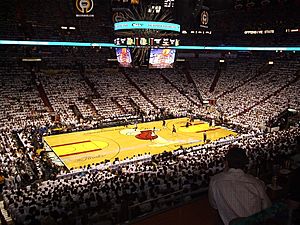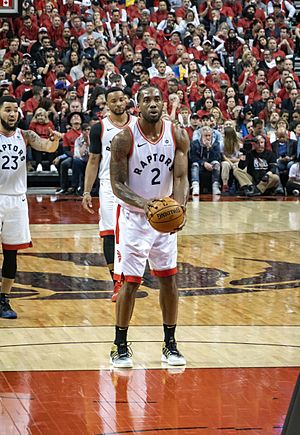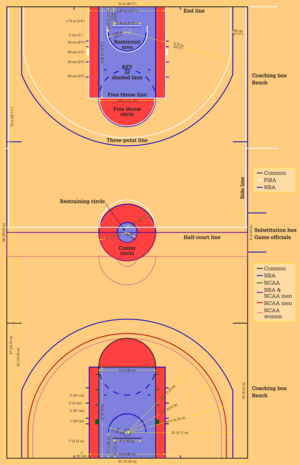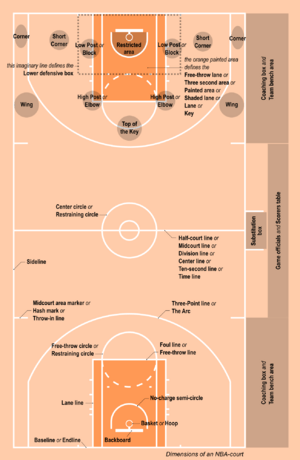Basketball court facts for kids

A basketball court is the special playing area where basketball games happen. It's a rectangular floor with a basket at each end. Most indoor courts are made of shiny wood, usually maple, and the baskets are always 10 feet (about 3 meters) high. Outside courts are often made of concrete or asphalt. Sometimes, for big international games, you might even see cool glass basketball courts!
Contents
Court Sizes
Basketball courts come in different sizes, depending on where you play.
- For professional games in the National Basketball Association (NBA), the court is 94 feet long and 50 feet wide (about 28.65 by 15.24 meters).
- For international games, following International Basketball Federation rules, the court is a bit smaller: 28 meters long and 15 meters wide (about 91.86 by 49.21 feet).
- Many high school gyms have courts that are 84 feet or even 74 feet long.
- No matter the size of the court, the basket rims are almost always 10 feet (3.05 meters) above the floor.
Every basketball court has a special line called the three-point arc around each basket. If you shoot the ball from behind this line and score, your team gets three points! If you shoot from inside this line, or if your foot touches the line, it's worth two points. There's also a free throw line, 15 feet (4.57 meters) from the backboard. Players stand here to take foul shots, which are worth one point each.
Court Measurements at a Glance
Here's a quick look at how court sizes compare in different leagues:
Important Areas of the Court
The Center Circle
At the very start of a game, two players from opposite teams stand in the center circle for the "jump ball." The referee throws the ball into the air, and these players jump to tap it to a teammate. Only these two players are allowed in the circle before the jump ball.
The Three-Point Line
This curved line marks where you can shoot for three points! If you shoot from behind this line and score, it's a "three-pointer." If your foot is on the line when you shoot, it only counts as two points. If you get fouled while shooting a three-pointer and miss, you get three free throws. If you get fouled and still make the shot, you get one free throw.
The distance of the three-point line from the basket can be different depending on the league:
- High schools in the US: 19.75 feet (6.02 meters)
- FIBA (international) and NCAA (college): 21.65 feet to 22.15 feet (6.60 m to 6.75 m)
- WNBA (women's professional): 22 feet to 22.15 feet (6.71 m to 6.75 m)
- NBA (men's professional): 22 feet to 23.75 feet (6.71 m to 7.24 m)
The NBA first used the three-point line in the 1979-80 season. FIBA and the NCAA started using it in 1986. Over the years, some leagues have changed the distance of this line to make games more exciting.
The Perimeter
The perimeter is the area on the court that is outside the "key" (the painted area under the basket) but inside the three-point line. Shots made from this area are called "perimeter shots" or "outside shots."
The Low Post Area
This area is very close to the basket, but just outside the painted "key." It's a super important spot for strategy in basketball. Players who are good at playing in the low post can score many points without needing to shoot from far away.
The Key (Free Throw Lane)

The "key" is the painted area right under the basket. It's also called the free throw lane or shaded lane. In the NBA, it's 16 feet wide. One of the main rules for the key is that offensive players can't stay in it for more than three seconds at a time. This rule keeps players from just waiting under the basket for an easy score.
There's also a "no charge zone arc" drawn around the basket inside the key. This is a semi-circle where, most of the time, defensive players can't cause an offensive player to get a "charging foul." This means the offensive player can drive to the basket more freely in this small area. For most professional and college leagues, this arc has a radius of 4 feet (1.22 meters).
The Baseline
The baseline, or endline, is the boundary line at each end of the court. It's usually 50 feet long. After a team scores, the other team usually starts their next play by passing the ball in from the baseline.
Other Court Markings
NBA courts have a few other lines. There are hash marks near the key that show the "lower defensive box." This area helps referees decide if a defensive player can draw a charging foul. There are also lines on the sidelines that show where coaches can stand, called the "coaching box."
How FIBA Courts Changed
In 2008, FIBA (the international basketball organization) announced some big changes to court markings. These changes were put into place for major international games starting in 2010.
- The "key" changed from a trapezoid shape to a rectangle, just like in the NBA.
- The three-point line was moved back a bit, from 6.25 meters to 6.75 meters (about 22 feet, 1.7 inches).
- FIBA also added the "restricted area arc" under the basket, similar to the NBA's.
See also
- NBA records













